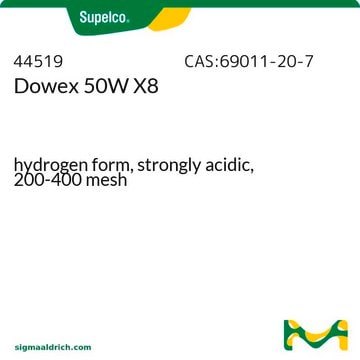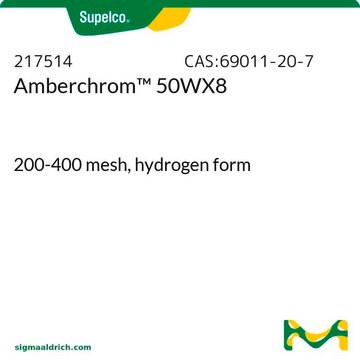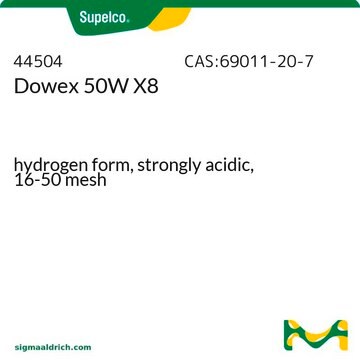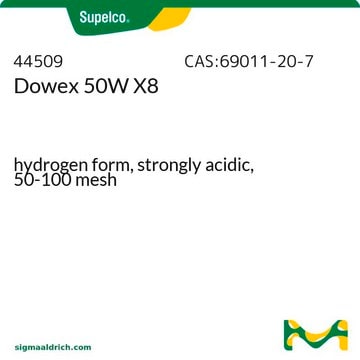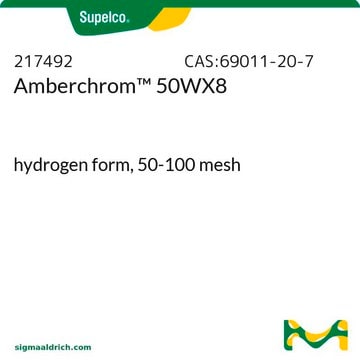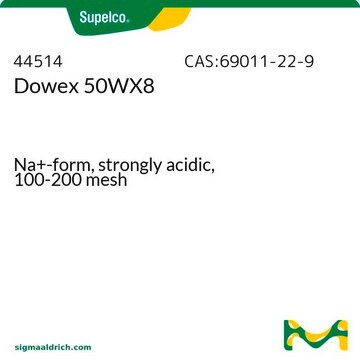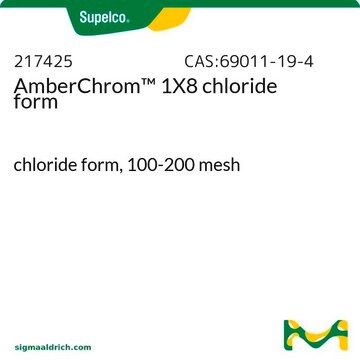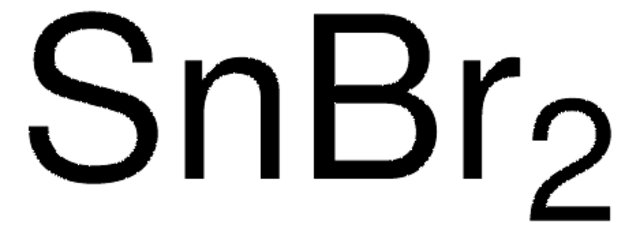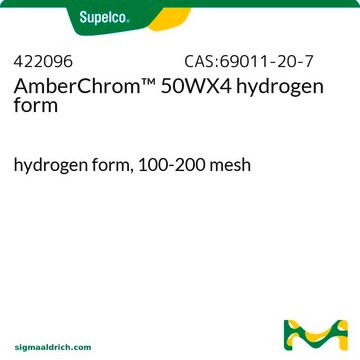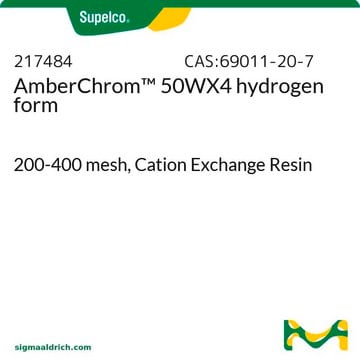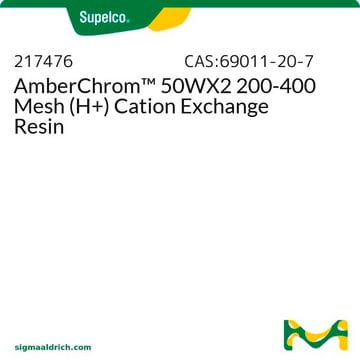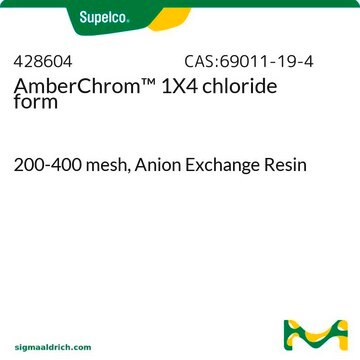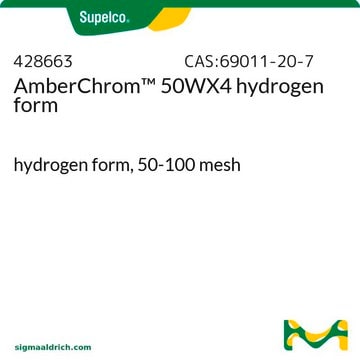This product is a strongly acidic cation exchange resin in the H+ form. There is no way to convert between this and being in the chloride form, which would constitute an anion exchange resin. A resin cannot be converted from an anion exchange resin to a cation exchange resin, or vice versa. A resin in the H+ form can, however, be converted to the sodium form by flushing with two volumes of 1 N NaOH, whereby the sodium ions take the place of the hydrogen.
217506
AmberChrom™ 50WX8 Ion Exchange Resin
hydrogen form, 100-200 mesh
About This Item
Recommended Products
Product Name
Amberchrom™ 50WX8, hydrogen form, 100-200 mesh
description
cross-linkage 8%
Quality Level
form
beads
moisture
50-58%
technique(s)
LPLC: suitable
matrix
styrene-divinylbenzene (gel)
matrix active group
sulfonic acid functional group
particle size
100-200 mesh
capacity
1.7 meq/mL by wetted bed volume
separation technique
cation exchange
SMILES string
C(C)c3c(cccc3)C=C.c2(c(cccc2)C=C)C=C.c1(ccccc1)C=C
InChI
1S/C10H12.C10H10.C8H8/c2*1-3-9-7-5-6-8-10(9)4-2;1-2-8-6-4-3-5-7-8/h3,5-8H,1,4H2,2H3;3-8H,1-2H2;2-7H,1H2
InChI key
NWUYHJFMYQTDRP-UHFFFAOYSA-N
Looking for similar products? Visit Product Comparison Guide
General description
Application
Other Notes
Legal Information
Signal Word
Warning
Hazard Statements
Precautionary Statements
Hazard Classifications
Eye Irrit. 2
Storage Class Code
13 - Non Combustible Solids
WGK
WGK 3
Flash Point(F)
Not applicable
Flash Point(C)
Not applicable
Personal Protective Equipment
Choose from one of the most recent versions:
Certificates of Analysis (COA)
Don't see the Right Version?
If you require a particular version, you can look up a specific certificate by the Lot or Batch number.
Already Own This Product?
Find documentation for the products that you have recently purchased in the Document Library.
Customers Also Viewed
-
How can a Dowex 1x4 resin in the chloride form be converted to the acidic form?
1 answer-
Helpful?
-
-
What is the meaning of 1.7 meq/mL by wetted bed volume for this resin? Do we have to consider the molecular mass of resin or the reaction mixture that we are going to purify?
1 answer-
A milliequivalent is one-thousandth of an equivalent. The unit mEq is related to the number (mmol) and electrical charge of ions in solution. 1.7 mEq/mL means 1.7 millimoles of charge per milliliter of resin bed.
Yes, you will need to consider the milliequivalents of charge on the resin and the millimoles of the material that you are trying to purify; make sure that the first is greater.
Helpful?
-
-
What is the particle size of Product 217506, Dowex® 50WX8 - hydrogen form, 100-200 mesh resin?
1 answer-
This is Dowex 50Wx8 100-200 mesh, with beads measuring 75-150 microns. This particle size is consistent in water, but the resin will shrink when exchanged to other cationic forms, and it will swell when exposed to organic solvents. You may test the swelling characteristics of a resin to be used in your application by doing the initial solvent exchanges in a graduated cylinder.
Helpful?
-
-
How do I prepare Product 217506, Dowex® 50WX8 - hydrogen form, 100-200 mesh resin, for use?
1 answer-
Cation exchange resins can be prepared by initially swirling with deionized water in a flask (no stir bars, please), allowing them to settle for 15-20 minutes, and decanting the fines. To fully activate the resin, repeat the procedure 2-3 times with 2N hydrochloric or sulfuric acid, and rinse with copious amounts of water until >pH 5; this procedure may be completed with use of a Büchner funnel.
Helpful?
-
-
Is Product 217506, Dowex® 50WX8 - hydrogen form, 100-200 mesh resin, the same as AG50W-X8?
1 answer-
The AG® designation indicates that a resin has been specially cleaned and certified for analytical use. In most cases, resin that you prepare yourself will be suitable for your application. (® Bio-Rad Laboratories, Hercules,CA)
Helpful?
-
-
What is the Department of Transportation shipping information for this product?
1 answer-
Transportation information can be found in Section 14 of the product's (M)SDS.To access the shipping information for this material, use the link on the product detail page for the product.
Helpful?
-
-
How can I convert a cation exchange resin from the hydrogen form to the sodium form?
1 answer-
To convert a cation exhcange resin from the hydrogen form to the sodium form, use two to four bed volumes of 0.5-2.0% NaCl or NaOH.
Helpful?
-
Active Filters
Our team of scientists has experience in all areas of research including Life Science, Material Science, Chemical Synthesis, Chromatography, Analytical and many others.
Contact Technical Service